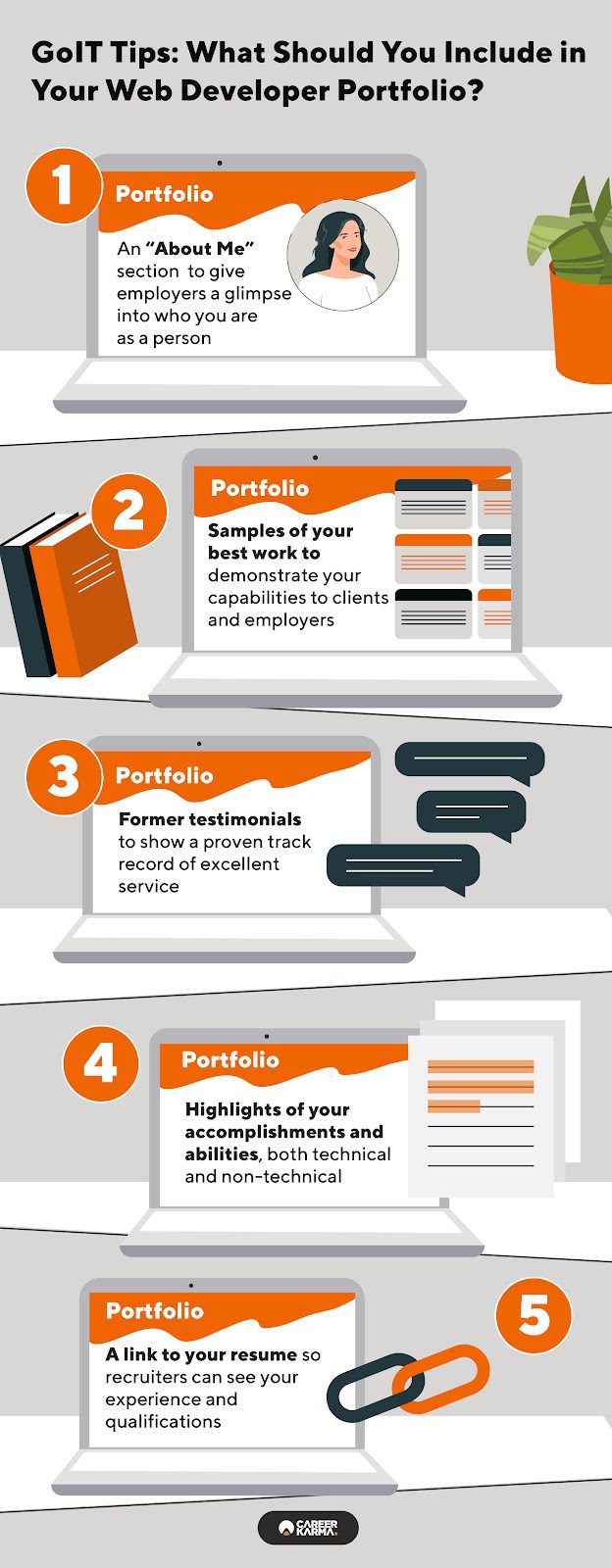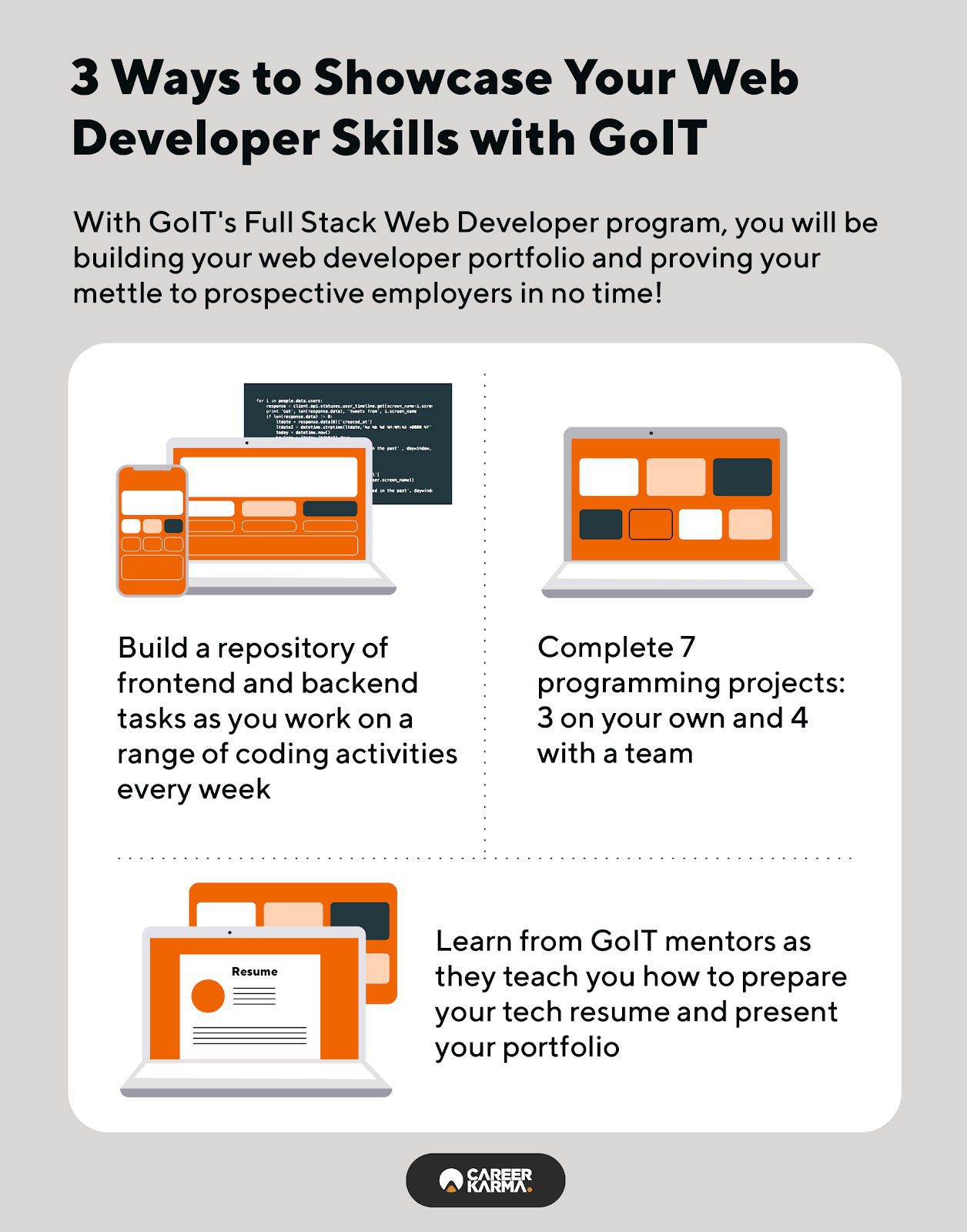When it comes to landing a job, it’s always better to showcase your skills rather than just talk about them. This is especially true in software and web development, where employers need tangible proof that you can write clean code, build end-to-end projects, and use your problem-solving skills to tackle challenges.
For this reason, programming portfolios have become essential when applying for web developer jobs. A programming portfolio includes a collection of your previous web development projects like those you may have developed for previous clients or personal reasons.
If you’re a career switcher or a career starter, you can leverage your programming portfolio to establish your skills and potential as a web developer. But for someone with little to no professional experience in this field, building an impressive portfolio is easier said than done.
This is where GoIT, a tech education company, comes in. Through its comprehensive Full Stack Web Developer program, you can complete several projects and compile them to build a strong portfolio. If you’re wondering what that looks like, this article gives a sneak peek and shows how you can build your portfolio with GoIT.
GoIT helps you showcase your web development skills to potential employers by showing you how to create an impressive portfolio of programming projects.
Start building your web developer portfolio with GoIT.What Should Be in Your Programmer Portfolio?

There’s more to building a strong web developer portfolio than just listing your previous projects. Other elements that are essential to a great portfolio are described in detail below.
About Me Section
While your portfolio primarily shows your coding experience and abilities, the “About Me” section gives employers an idea of who you are as a person. This section should contain an introductory statement that gives a brief overview of yourself, your passions, professional experience, contact information, and a photo.
Adding to that, include a brief blurb that mentions who you are as a professional developer and how you wish to further your career. This gives prospective employers an insight into whether you’re a good fit for their team.
Provide Samples of Your Best Projects
Your portfolio is a good way to make a positive first impression on your prospective clients or employer. Hence, you want to provide examples of your best work and projects. That may include samples of your top freelancing jobs or personal projects, which best demonstrates your coding skills and problem-solving approach.
Don’t just make a bulleted list of your projects. Instead, write a clear outline that walks employers through your project-building process. Make sure to include the initial objective of your project, your complete methodology, and other relevant information.
Show your code in pictures, videos, GIFs, or embed links to a live review or GitHub repository. You may also want to organize your source code, ensuring it follows the folder structure and naming conventions. That way, employers can more easily follow your code and understand your approach.
Client Testimonials
Include your former clients’ or employer’s testimonials in your portfolio to show a proven track record of excellent service. One unique way to include testimonials is to use them as case studies and provide relevant details along with featured projects.
Skills and Achievements
Alongside your best projects, you should also provide highlights of your achievements and skills. This should cover your core competencies—including technical and soft skills. Highlighting your past professional achievements also showcases the level of responsibility a company can expect you to handle.
Link to Your Resume
While your portfolio sells your practical experience and capabilities, your resume tells others more about your educational and professional history. It also provides a more concise representation of your core skills and achievements.
Creating a web developer portfolio can be more challenging in practice than it appears. Determining which projects are portfolio-worthy and how to design an appealing portfolio are just a few of the challenges young developers face when creating a programming portfolio. But with GoIT’s unique offerings, students can seamlessly create compelling profiles.
How to Build a Web Developer Portfolio with GoIT

GoIT gives a multi-faceted approach to building quality web developer portfolios with students. The hands-on learning, capstone projects, and career services that GoIT offers form the pillars of the students’ portfolios.
Hands-on Learning Approach
By providing practical assignments and projects throughout the program, GoIT helps students build a repository of various frontend and backend tasks and projects. It offers weekly coding sessions where students will learn to write code and describe all tags, steps, and processes.
These activities also allow students to gain a better understanding of their core interests and competencies.
Capstone Projects
At GoIT’s Full Stack Web Developer program, students complete seven projects— three of them are personal, and four are team projects. After learning about each framework, students complete a personal project and a team project. By the end of the program, students would have built enough projects to create a portfolio.
Dmitry N., a GoIT graduate who had no prior tech experience, shared how he built his first programming portfolio with the help of the online learning platform.
“It was hard to find my first job. Everyone needs commercial experience, and you cannot have this unless you are employed. I did numerous pet projects while studying. Moreover, during my studies, I learned about some additional frameworks and did several tutorials on the Internet,” he shared. “Having created a portfolio of 15 projects, it was time to start my job search.”
The entire project-building process not just hones students’ technical know-how but also sharpens their soft skills such as how to work in a team, delegate tasks, and create a project from end to end.
Career Services
Once he had built his portfolio, Dmitry started his job search. This is where GoIT’s career services kicked in. The services are around to help students during their job search and interview preparation. Mentors teach students how to prepare tech resumes and portfolios. They offer career coaching sessions and provide feedback on the students’ experiences with job search and portfolio building.
Throughout his job search, Dmitry landed five job interviews and received three job offers, and eventually picked the job that offered the most room for growth.
“I wanted to grow as a developer. I wanted a company with an environment where I could grow quickly from a junior-level to a mid-level professional in about a year. I needed mentorship, project reviews, and interesting tasks to work on,” he shared.
Show, Don’t Just Talk About Your Programming Skills
GoIT’s curriculum and offerings help learners hone their web development skills, alongside other vital soft skills. The program design ensures that participants have ample projects to prove their mettle as web developers.
As a result of GoIT’s job-focused approach, the bootcamp has excellent outcomes ratings. In Dmitry’s words, “If you decide to go for it and focus on the work you do every day, you will succeed.” He completed his program, landed his first tech job with a big Ukrainian company, and has now moved on to his second tech job.
You can start your career with GoIT today and achieve a seamless transition into tech.
About us: Career Karma is a platform designed to help job seekers find, research, and connect with job training programs to advance their careers. Learn about the CK publication.




